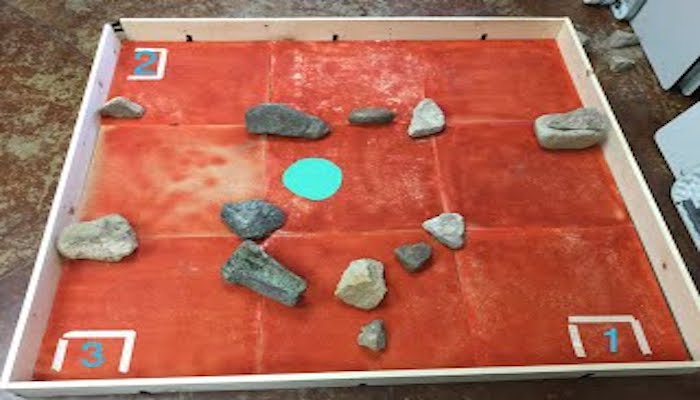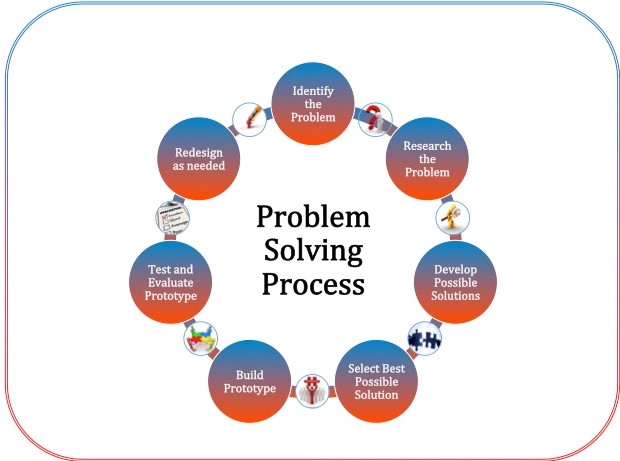Project 1 Is there life on Mars?

A Project-based STEM+Computing Inquiry
About
This project was supported by the National Science Foundation (NSF) under Grant Number 1640228. Any opinions, findings, conclusions, or recommendations expressed in this project are those of the author(s) and do not necessarily reflect the views of the National Science Foundation. If you have any questions, please contact Dr. Dazhi Yang at dazhiyang@boisestate.edu or use our Contact Form.
Description
This project-based scientific inquiry project: Is There Life on Mars? is centered on designing robots and testing them on a simulated Mars. In this project, students work in small groups to explore and research the existence of life on Mars. Then they design and develop robots to detect life on a simulated Mars. Students learn how to program related science and engineering concepts into the designing of robots using Mindstorms EV3 Legos. To develop computational thinking and an understanding of STEM subjects, students from 4th, 5th and 6th grade will work in small groups of six, with one in-service and one pre-service teacher, twice a week for eight weeks in a community centers after-school program.
Implementation
Please refer to the weekly activities (such as Week 1 Session 1 in the left sidebar and Resources from the sections below) for detailed information on how to use this project either in a classroom or an informal setting such as in community centers' after-school programs. The twice weekly sessions were originally designed to be 90 minutes in length, including a 10 minute break in the middle of the session. See photos of prior implementations on the projects' photo pages.
Week 1
Session 1
Questions
What is the goal of this project?
What does life consist of?
Goal
To understand the project goal
To understand the problem solving process
To understand the problem that drives the current project
To know each other in the team and prepare for team work
Activities
Watch videos on Mars
Learn about the final competition
Learn about the problem solving process
Research the forms of life
Resources
Video on Mars
Problem Solving Process diagram
Web-resources on life
Outcomes
Journal writing/research recording
Forms of life
Session 2
Questions
What is a Robot?
What are the components of a robot?
Goal
To understand the roles of robots in society.
To name the robot components
To name the parts of EV3 and their specific functions
To understand how the motors and wheels work on the robot
Activities
Watch videos on Robot
Learn about the components of a robot
Learn about EV3 robot parts
Resources
Video on robot, EV3 parts/functions resources
Video on EV3 software environment
Worksheet 1
EV3 Software
Outcomes
Robot’s functions
List of EV3 parts/functions
A short code on turning on and turning off the motors of EV3
Part 1
How can we detect life on Mars using a robot?
Intro 5-10 minutes
Teacher introduces the project: "In the next eight weeks, we will explore life, Mars, and learn how to design, build, and test a robot to detect life on a simulated Mars. Can anyone tell us what you know about Mars? (Thank you for your sharing... now lets start to explore Mars...) Before we start our exploration, let’s watch this video: . (Watch this video from 0 to 5s, can fast play before 2min 57s if needed.)
The Problem 10 minutes
Teacher introduces the problem to students:There will be a competition at the end of this program. During the competition, robots need to find water in a simulated Mars environment.

The robots need to move from the starting points, avoid the rocks, and find the water. The robot that finds the water in the least amount of time will win the competition. The group who designs the winning robot will get a prize. Throughout the next few weeks, you will learn about what life consists of, what the environment on Mars looks like, how to build a Lego Mindstorms robot, and how to make the robot move and find water.
Problem Solving Process
We will be using a problem solving process to tackle the problem of "how can we detect life on Mars using a robot". How do you usually solve a problem? (Have several students answer this questions before moving on).
Now look at the problem solving process diagram. Can you see how your problem solving steps map onto this diagram? Let's discuss the steps we will go through to be able to solve a problem systemically. We will use these steps to achieve our mission.

Team Building 15 minutes
Some possible activities (Use any team-building activity appropriate for the age level):
Self-introduction in the team: name and what are you good at
Select a team name
Design a team logo
Identify roles for each team member for the mission of "Detecting Life on Mars."
10 minute break
Part 2
How can we detect life on Mars using a robot?
Entry Event 5 minutes
A teacher asks, “What is life?” and shows the students pictures of a person, dog, lobster (form of life); PAUSEs and asks “do you think they are a form of life? ”;
Next, showing students pictures of a tree, fruit, mushroom, coral (form of life); PAUSEs and asks “do you think they are a form of life?”;
Then, showing students pictures of a rock, metal, pencil (not a form of life); PAUSEs and asks “do you think they are a form of life?;
Finally, showing students a picture of a cell, virus, fungus and other forms of microorganism (form of life and leads students to think beyond the life forms they normally can see and observe); PAUSEs and asks “do you think they are a form of life?;
Ask student to have a hypothesis of what life is and then set out to test their hypothesis through research.
What does life consist of? Small-group Hands-on Scientific Inquiry 20 minutes
Students research about life, forms of life, and conditions for life, They answer the question and produce a group report on this research question; they need to take notes on the important facts and knowledge they found during their research (need to discuss the individual roles and the rotation of role in this process)
Resources
Problem Solving Process Diagram
Student Pre-Survey 20 minutes
Students fill out the pre- survey in the first session to establish the baseline data. The researchers will prepare the surveys. Teachers will collect the completed surveys and return the surveys to the researchers on site.
End of Session Reflection and Debriefing 5-10 minutes
Teacher briefly explains the computational thinking (CT) skill embedded in the Problem Solving Process Diagram. Using the problem solving process diagram, the teacher will ask students to identify what kind of problem solving skills/process/computational thinking they used in this session and explain how they used it. The following are some sample questions that can guide the debrief.
What did I learn today?
What problem solving skills/processes or CT components in this diagram did I use today?
How did I use the problem solving skills/processes/CT components?
Part 1
How can we detect life on Mars using a robot?
Entry Event 10 minutes
Show students the .
Teachers can ask the following questions:
What do robots do?
What are the components of a robot?
If a robot can do only what it has been programmed to do, can you say a robot is able to think? What does it mean to be able to think?
What are the components of a Lego Mindstorms robot? Small-group Hands-on Scientific Inquiry 30 minutes
Provide a Lego Mindstorms kit for each small group. Distribute laptops to students.
Briefly introduce EV3 robot parts to the students: P-Brick, motors, sensors, and cables. Information about each part is provided here: Intro to Lego Mindstorms Parts.
In small groups, let the students see, touch, and name these parts. Students can also read more about the functions of the sensors and motors. Resources are provided below.
Have students take notes on the functions of the different types of sensors and the ports on the P-Brick.
Have students assemble the sensors and motor. After assembling, have students open the EV3 program on the laptop and create a new project. Connect the P-Brick to the laptop. At the bottom right of the program, students can see the values of the sensors. Have students explore those values.
Resources
"Show EV3 Help" in the EV3 Software environment.
10 minute break
Part 2
How can we detect life on Mars using a robot?
Entry Event 10 minutes
A teacher asks following questions:
How do we make Lego Mindstorms robot do what we want them to do?
What is programming?
What programming experiences do you have?
How do we program our Lego robots? Small-group Hands-on Scientific Inquiry 30 minutes
Show students a video that introduces the EV3 software environment:
Direct students to click on the "Help" on the top menu in the EV3 software environment and click on "Show EV3 Help."
Have students read more about programming in "Show EV3 Help > General > Programs." In the future, whenever students need to research about EV3 programming blocks, have them use "Show EV3 Help".
Distribute Worksheet 1 to the students.
Have students open the EV3 software.
Have students read the Problem stated on Worksheet 1.
Have students research and explore relevant blocks needed to solve the problem on Worksheet 1 by reading about the information in "EV3 Help > Programming Blocks."
Have a group discussion on the problem and possible solutions.
Have students test their solutions and debug.
Collect the finished worksheets.
Resources
How to create your first program - LEGO Mindstorms Tutorial
Introduction to EV3 LEGO Mindstorms Programming
End of Session Reflection and Debriefing 5-10 minutes
Teacher briefly explains the computational thinking (CT) skill embedded in the Problem Solving Process Diagram. Using the problem solving process diagram, the teacher will ask students to identify what kind of problem solving skills/process/computational thinking they used in this session and explain how they used it. The following are some sample questions that can guide the debrief.
What did I learn today?
What problem solving skills/processes or CT components in this diagram did I use today?
How did I use the problem solving skills/processes/CT components?